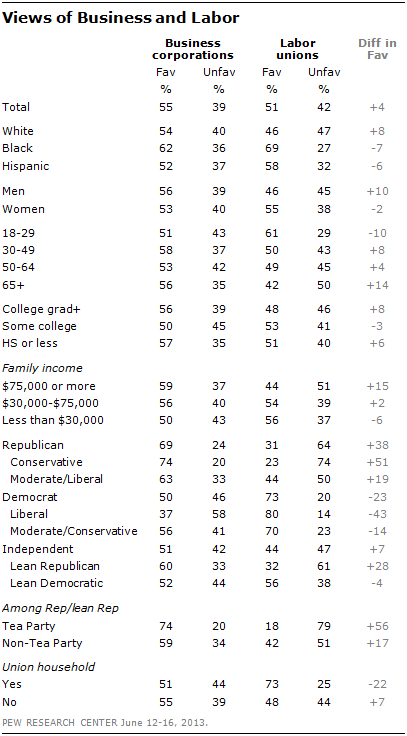 It seems the economic recession soured people on both corporations and labor unions, but a recent Pew survey, Favorable Views of Business, Labor Rebound, shows people’s impression of both are now more favorable.
It seems the economic recession soured people on both corporations and labor unions, but a recent Pew survey, Favorable Views of Business, Labor Rebound, shows people’s impression of both are now more favorable.
Overall, more Americans now hold a favorable (55%) than an unfavorable (39%) view of business corporations; two years ago, opinion was reversed (52% unfavorable, 38% favorable). Similarly, views of labor unions have returned to positive territory, with 51% holding a favorable view and 42% holding an unfavorable view – far better ratings than the 46% unfavorable/41% favorable balance of opinion registered in 2011.
Some numbers (favorable/unfavorable view):
Business
- Men 56/39
- Women 53/40
- White 54/40
- Black 62/36
- Hispanic 52/37
- Republican 69/24
- Democrat 50/46
- Independent 51/42
Labor unions
- Men 46/45
- Women 55/38
- White 46/47
- Black 69/27
- Hispanic 58/32
- Republican 31/64
- Democrat 73/20
- Independent 44/47
In a piece for The American Prospect, The State of the Unions, Harold Meyerson write about the study, as well as a similar one conducted by Gallup last year that showed similar numbers.
So unions are modestly, sorta, kinda back, in the public’s estimation. Back, that is, from the trough into which they fell during the first year of the recession, when their approval ratings toppled from the high-50s (Gallup) and the mid-50s (Pew) by ten points in each poll. The auto bailout of that year, and the constant drumbeat in much of the media that auto workers were being paid between $75,000 and $100,000 (in reality, the very best paid were pulling down $56,000, and there weren’t that many of them), looks to have done lasting damage to unions’ favorability ratings, which have stalled out about 5 percentage points beneath their pre-recession, pre-bailout peak.
Meyerson also point out that young people have a favorable impression of unions, but a very small number of them belong to unions — only 4.2 percent of workers younger than 25.
So wherever young people got their disproportionately favorable impression of unions, it didn’t come from their personal exposure to them. Then again, young people in the early 1930s—a time when union membership collapsed, along with the economy in general—didn’t have much personal exposure to unions either, yet they became the most pro-union generation in American history. What both these generations have in common is a far greater skepticism about the economy in general and a much stronger belief that the economy is rigged to ordinary workers’ disadvantage.
On AFL-CIO Now, the California Labor Federation’s Rebecca Band writes about the challenge of organizing young workers in Kids These Days: Unions, Workers’ Rights and the ‘Now’ Generation.
Whether they’re food service workers or Ph.D. candidates, my generation recognizes that corporations are out of control, and something has got to change. The labor movement can be that change. We can turn the tables on corporate greed. We can expand our ranks to nontraditional organizing efforts. We can connect with young people in our communities and educate them about what unions have to offer for them. We can inspire them to fight for their rights. And we can make space for them in our unions, councils, organizations and campaigns—because if we give them an outlet where they and their peers can feel comfortable getting involved, we can groom new activists and future leaders, and that’s the only way we can restore and grow the labor movement.